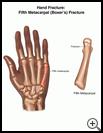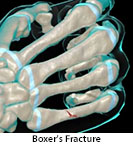
Hand Fracture: Fifth Metacarpal (Boxer's) Fracture
________________________________________________________________________
KEY POINTS
- A boxer’s fracture is a break or crack in the long bone that attaches to the pinky finger.
- Treatment may include surgery, a splint or cast, and special exercises to help your hand get stronger and more flexible.
- Follow the full course of treatment your healthcare provider prescribes.
________________________________________________________________________
What is a boxer’s fracture?
A boxer’s fracture is a type of hand fracture. It is a break or crack in the long bone (fifth metacarpal) that attaches to the pinky finger. The break may be just a bend or small crack in the bone, or the bone may break into pieces or shatter. Some fractures may stick out through the skin.
The long bones in the hand are called metacarpals.
What is the cause?
A boxer’s fracture can happen from falling or hitting something with your fist. A fracture may also be the result of a medical condition that causes weak or brittle bones.
What are the symptoms?
Symptoms may include:
- Pain, swelling, bruising, or tenderness on the pinky finger side of the hand that happens right after the injury
- Pain when the injured area is touched
- Pain or swelling that keeps your child from using the hand
- A bump on the side of the hand
- An area of the hand that is cold, pale, or numb
- A change in the shape of the hand
How is it diagnosed?
Your child’s healthcare provider will ask about your child’s symptoms and how the injury happened. Your provider will examine your child. Tests may include:
- X-rays of the hand
- CT scan, which uses X-rays and a computer to show detailed pictures of the bones
- MRI, which uses a strong magnetic field and radio waves to show detailed pictures of the bones
How is it treated?
The treatment depends on the type of fracture.
- If your child has an open wound with the fracture, your child will need treatment to control bleeding or prevent infection.
- If the broken bone is crooked, your child’s healthcare provider will straighten it. Your child will be given medicine first so the straightening is less painful.
- Sometimes surgery is needed to put the bones back into the right position.
- Your child’s healthcare provider will put your child’s hand and forearm in a cast or splint to keep the hand from moving while it heals. If your child has a cast, make sure the cast does not get wet. Cover the cast with plastic when your child bathes. Teach your child not to scratch the skin around the cast or poke things down between the cast and the skin. This could cause an infection.
With treatment, the fracture may take up to 6 weeks to heal. Your child may need to do special exercises to help the hand get stronger and more flexible. Ask your child’s healthcare provider about this.
How can I take care of my child?
Follow the full course of treatment your child’s healthcare provider prescribes. Also:
- To keep swelling down and help relieve pain, your healthcare provider may tell you to:
- Put an ice pack, gel pack, or package of frozen vegetables wrapped in a cloth on the injured area every 3 to 4 hours for up to 20 minutes at a time for the first day or two after the injury.
- Keep the hand up on pillows so that it is above the level of the heart when your child sits or lies down.
- Give your child pain medicine, such as ibuprofen, as directed by your provider. Nonsteroidal anti-inflammatory medicines (NSAIDs), such as ibuprofen, may cause stomach bleeding and other problems. Read the label and give as directed. Check with your healthcare provider before you give any medicine that contains aspirin or salicylates to a child or teen. This includes medicines like baby aspirin, some cold medicines, and Pepto-Bismol. Children and teens who take aspirin are at risk for a serious illness called Reye's syndrome.
Ask your child’s healthcare provider:
- How and when you will get your child’s test results
- How long it will take for your child to recover
- If there are activities your child should avoid and when your child can return to normal activities
- How to take care of your child at home
- What symptoms or problems you should watch for and what to do if your child has them
Make sure you know when your child should come back for a checkup.
How can I help prevent a boxer’s fracture?
Teach your child not to hit hard objects with his or her fist.
Last modified: 2018-01-02
Last reviewed: 2018-01-02


